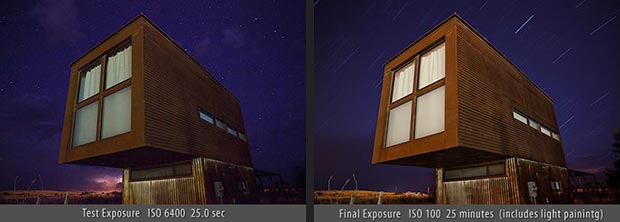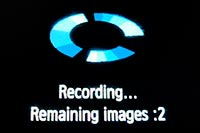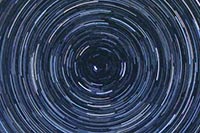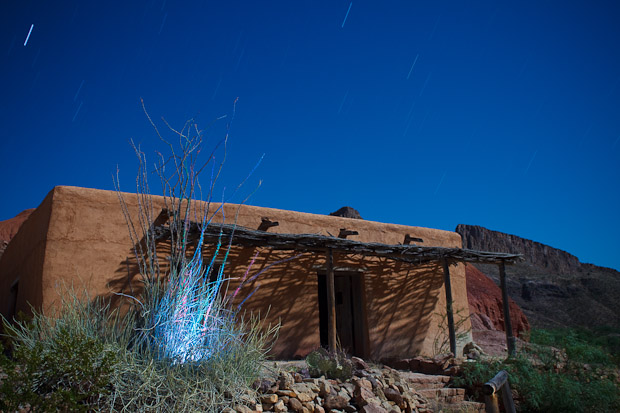Having used several cameras for a lot of long exposure night photography lately, I think the Canon 5Dmark2 is quite likely the best camera on the market for long exposure night photography right now. Here are some of the highlights:
6400 ISO for testing
Being able to take photos at 6400 ISO has huge benefits for the night photographer. Night photographers tend to waste a bunch of time taking long exposures only to discover they need to reshoot with a better exposure. Testing exposures at high ISOs can save huge amounts of time but doing so has been clunky as it requires complicated math when using a camera that has a ISO ceiling of 1600. Now that that ceiling has been lifted to include 6400 ISO we can make a direct translation from ISO 6400 exposures in seconds to ISO 100 exposures in minutes. For example, a 15 second exposure at ISO 6400 is the same as a 15 minute exposure at ISO 100 (Canon’s native ISO). Nikon users can figure that a 15 second exposure at 12, 800 ISO is the same as a 15 minute exposure at ISO 200 (Nikon’s native ISO).
Either way, this means a night photographer can quickly determine the optimal exposure at a high ISO before committing to a long, final exposure at the native ISO. This has provided me with significant time savings and more optimal exposures on the 5Dmark2.

Low noise
To make a long story short, the noise levels are shockingly low, even during very long exposures (like 30+ minutes at ISO 100). Even 6400 ISO images are less noisy than one would expect, and because the noise is embedded within such a high resolution (21 megapixel) image, the noise isn’t visible at all on 8×10 inch or smaller prints.
Live View
The Live View mode not only helps with frame composition at night, it zooms into a small area in the center allowing for incredibly precise focusing through the lens that’s far more reliable than focusing through the viewfinder or by using a focusing notch on the lens itself. This works when the depth of field preview button is depressed so, when there’s enough light, one can visually check depth of field as well. One needs to shine a flashlight on the object of focus but the level of confidence this provides, and success rate, is fantastic. The very latest DSLR’s from Nikon and Canon have Live View and most DLSRs are bound to have this feature from now on.
Resolution and flexibility
21 megapixels offers a lot of image detail and it leaves me with a feeling similar to switching from medium to large format. Processing these files is slow but I’m in awe of the detail and sharpness. While I was concerned that 21 megapixels might be too much for some projects I’ve found the 10 megapixel (half RAW) and 5 megapixel (quarter RAW) sRAW options to be quite useful.
Exposure length recording
Cameras record long exposure times in seconds. Most cameras only record 3 digits worth of seconds (illustrated below left) so any exposures over 999 seconds aren’t accurately noted in the EXIF data. The 5Dmark2 lifts this 3 digit limit so that longer exposures are accurate noted in the EXIF data (as illustrated below right).

Long Exposure Noise Reduction
Like most DSLR’s, the 5Dmark2 has the option to enable long exposure noise reduction. With this option enabled, the camera takes a second dark exposure and subtracts the noise signature from the original image (also known as dark frame subtraction). This is applied both to JPEGs and to RAW files and results in a significant reduction in noise that is superior to noise reduction efforts in RAW processing applications and even filters in Photoshop. So if one takes a 15 minute exposure, the noise reduction takes an additional 15 minutes to complete. Most DSLRs have this feature.
Low ISOs translate into long star trails
Like any other Canon, the ability to use 100 and even 50 ISO has the significant advantage of capturing longer and more impressive star trails. I’ve taken many night images at 50 ISO that I couldn’t have done at any other ISO.
All of the above advantages aren’t unique to the Canon 5Dmark2 and can be found in some of the other newest cameras from Nikon and Canon. The features below are unique to the 5Dmark2.
Long Exposure Noise Reduction Buffering and Usability
 The 5D and 5Dmark2 both allow you to start taking a new photo, while temporarily holding (buffering) the noise reduction processing for later. Both cameras allow you to buffer several images worth. For example one can take four 10 minute exposures back-to-back and the camera will process noise for 40 minutes afterwards. The 5Dmark2 is unique in that it tells you how many images are in the buffer when the power switch is turned to off. The camera doesn’t actually turn off until it’s completed the noise reduction processing. The 5Dmark2 also gives the user full control over image review and menu access during noise processing. All of these things add up to significant productivity savings for the night photographer who might otherwise be waiting around 30+ minutes for his/her camera to finish noise processing.
The 5D and 5Dmark2 both allow you to start taking a new photo, while temporarily holding (buffering) the noise reduction processing for later. Both cameras allow you to buffer several images worth. For example one can take four 10 minute exposures back-to-back and the camera will process noise for 40 minutes afterwards. The 5Dmark2 is unique in that it tells you how many images are in the buffer when the power switch is turned to off. The camera doesn’t actually turn off until it’s completed the noise reduction processing. The 5Dmark2 also gives the user full control over image review and menu access during noise processing. All of these things add up to significant productivity savings for the night photographer who might otherwise be waiting around 30+ minutes for his/her camera to finish noise processing.
Battery Life
 With continuous shooting starting at 9pm I found I could shoot till 3-4am on a single battery on the 5Dmark2. This is well over twice the battery life most cameras have, including the original 5D. Canon tells me that moving the mirror, shutter and lighting the LCD display are the primary culprits of battery drain. It’s also been suggested that 4-8 hour exposures shouldn’t be a battery life problem since the sensor uses so little energy during the exposure itself. I’ll have to stock up on some neutral density filters and test this theory. If it’s true that we can achieve 8+ hour exposures without battery problems, then we can achieve the long star trails that we’ve come to know and love from film-based night photography. I know one can always “stack” lots of short exposures, but doing a single long exposure would fun to test.
With continuous shooting starting at 9pm I found I could shoot till 3-4am on a single battery on the 5Dmark2. This is well over twice the battery life most cameras have, including the original 5D. Canon tells me that moving the mirror, shutter and lighting the LCD display are the primary culprits of battery drain. It’s also been suggested that 4-8 hour exposures shouldn’t be a battery life problem since the sensor uses so little energy during the exposure itself. I’ll have to stock up on some neutral density filters and test this theory. If it’s true that we can achieve 8+ hour exposures without battery problems, then we can achieve the long star trails that we’ve come to know and love from film-based night photography. I know one can always “stack” lots of short exposures, but doing a single long exposure would fun to test.
Update (6-13-09)
Several people have asked me “Don’t Nikons like the D700 and D3 do all of these as well?” As for the long exposure noise reduction bufferin, battery life and lower ISO items mentioned above, the answer is no. Even Canon’s flagship 1Dsmk3 doesn’t have these (except the 50 ISO). For some reason it’s only the 5D family that have these features. When other cameras are processing long exposure noise reduction the camera is dark and unresponsive – you can’t review images, go through the menu or start taking a new exposure. In addition, if you turn the power to off on a Nikon you don’t loose the exposure but you will loose the noise processing. Canons are smarter about staying on the finish noise processing before shutting down.
Nikons have some unique features for night photography that are worth mentioning. First of all, the latest Nikon cameras have slightly better dynamic range and light sensitivity at 200 ISO than the latest Canon cameras do even at 100 ISO (visit www.dxomark.com for more info). Image Overlay allows for several separate frames to be taken and combined into a single RAW file. A night photographer might use this to take a photo at last light, wait a while and do a second exposure for the sky in complete darkness. Image Overlay could also be handy when working with complex light painting.
Update (10-23-09)
At recent night photography workshops I’ve had Nikons, Canons, Pentax, Sonys, Leicas, Hasselblads and Phase One cameras shooting side-by-side and I’ve closely compared the results. Newer cameras are obviously much cleaner and less noisier than older bodies. The D700 and D3s really are the cleanest 12 megapixels you’ll ever see and the smoothness is so fantastic that many owners just skip the long exposure noise reduction altogether which is nice. The D3s is my favorite camera in the whole world in terms of feel and usability – gotta love it! But the benefits of the additional resolution from a higher resolution camera adds up. While higher resolution cameras (like the 5dmk2, 1Dsmk3, 1Dmk4, even the D3x) aren’t as noise free as Nikon’s 12 megapixel brethren, the noise of the 5Dmk2 is slight, small and unperceptable on small prints. When larger resolution files with a little bit of noise are lowered to the equivalent of 12 megapixels the noise smoothes out and the overall image becomes cleaner. Different solutions for different people. For some an immaculate 12MP is better than a very clean 21MP and visa versa. On one hand I like the smaller file size of a 12 mp file and on the other hand the additional resolution of a 20+ megapixel file translates into quality when printed large. A D700 or D3s might be the best “low light” cameras for, say, wedding photographers making smaller prints but the 5Dmk2’s extra resolution, lower ISO’s and long exposure noise reduction buffering are huge advantages for long exposure night photography.
Hasselblad, Phase One and Leica cameras perform *much* better at their native ISOs than at higher ISOs at night. Phase One plus backs curiously won’t allow the long exposure noise reduction to be turned off, so the user always has to wait for processing before the image can be seen or before the next shot can be taken. This eliminates the possibility of multiple exposure image stacking. These cameras don’t quite have the exposure flexibility that having a programmable, digital remote timer provides.
I think these differences are fun to talk about and hope readers don’t view this article as a religious Canon vs Nikon article – it certainly isn’t. I like them both as well as other brands and strive to be as unbiased as one can be. Each brand has it’s advantages and disadvantages and the discussion between them is valuable when brand loyalty (which is destructive to conversation) is set aside. Long exposure night photography is especially fun way of analyzing these differences because it stretches cameras to their limits and is an area that, for the most part, manufacturers haven’t spent much time tweaking their cameras for.

